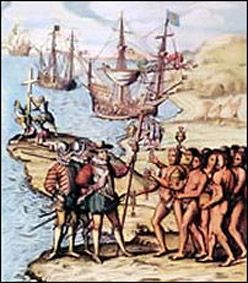 Ancestors of European Americans have long been blamed for the deaths of millions of native populations after the arrival of Columbus. It is commonly held that Americans of European descent are retroactively complicit in the widespread loss of life due to disease in the 16th century. This loss of millions of lives is viewed by many historians as deliberate. Such blaming has lead to militant Hispanic hatred of Whites in America and the rhetoric that Hispanic immigrants “have got to eliminate the gringo”, that they “have got to kill him”, as well as expressed intentions to seize the American southwest, an area they call “Atzlan”.
Ancestors of European Americans have long been blamed for the deaths of millions of native populations after the arrival of Columbus. It is commonly held that Americans of European descent are retroactively complicit in the widespread loss of life due to disease in the 16th century. This loss of millions of lives is viewed by many historians as deliberate. Such blaming has lead to militant Hispanic hatred of Whites in America and the rhetoric that Hispanic immigrants “have got to eliminate the gringo”, that they “have got to kill him”, as well as expressed intentions to seize the American southwest, an area they call “Atzlan”.
A Mexican epidemiologist, Rodolfo Acuna-Soto, made some research discoveries that muddle claims of intentional genocide by the Spanish: Smallpox seems to have existed in America before the arrival of the Spanish colonists, and the epidemics of 1545 and 1576 “seem to be another disease altogether“. His work demonstrates how vitally important ongoing historical research is to reality and to the protection of the rights of innocent people in the 21st century, in this case, the right of European Americans to exist in America. -Staff 2
Megadeath in Mexico
Epidemics followed the Spanish arrival in the New World, but the worst killer may have been a shadowy native—a killer that could still be out there.
published online February 21, 2006
When Hernando Cortés and his Spanish army of fewer than a thousand men stormed into Mexico in 1519, the native population numbered about 22 million. By the end of the century, following a series of devastating epidemics, only 2 million people remained. Even compared with the casualties of the Black Death, the mortality rate was extraordinarily high. Mexican epidemiologist Rodolfo Acuña-Soto refers to it as the time of “megadeath.” The toll forever altered the culture of Mesoamerica and branded the Spanish as the worst kind of conquerors, those from foreign lands who kill with their microbes as well as their swords.
The notion that European colonialists brought sickness when they came to the New World was well established by the 16th century. Native populations in the Americas lacked immunities to common European diseases like smallpox, measles, and mumps. Within 20 years of Columbus’s arrival, smallpox had wiped out at least half the people of the West Indies and had begun to spread to the South American mainland.
In 1565 a Spanish royal judge who had investigated his country’s colony in Mexico wrote:
It is certain that from the day that D. Hernando Cortés, the Marquis del Valle, entered this land, in the seven years, more or less, that he conquered and governed it, the natives suffered many deaths, and many terrible dealings, robberies and oppressions were inflicted on them, taking advantage of their persons and their lands, without order, weight nor measure; . . . the people diminished in great number, as much due to excessive taxes and mistreatment, as to illness and smallpox, such that now a very great and notable fraction of the people are gone. . . .
There seemed little reason to debate the nature of the plague: Even the Spanish admitted that European smallpox was the disease that devastated the conquered Aztec empire. Case closed.
Then, four centuries later, Acuña-Soto improbably decided to reopen the investigation. Some key pieces of information—details that had been sitting, ignored, in the archives—just didn’t add up. His studies of ancient documents revealed that the Aztecs were familiar with smallpox, perhaps even before Cortés arrived. They called it zahuatl. Spanish colonists wrote at the time that outbreaks of zahuatl occurred in 1520 and 1531 and, typical of smallpox, lasted about a year. As many as 8 million people died from those outbreaks. But the epidemic that appeared in 1545, followed by another in 1576, seemed to be another disease altogether. The Aztecs called those outbreaks by a separate name, cocolitzli. “For them, cocolitzli was something completely different and far more virulent,” Acuña-Soto says. “Cocolitzli brought incomparable devastation that passed readily from one region to the next and killed quickly.”
After 12 years of research, Acuña-Soto has come to agree with the Aztecs: The cocolitzli plagues of the mid-16th century probably had nothing to do with smallpox. In fact, they probably had little to do with the Spanish invasion. But they probably did have an origin that is worth knowing about in 2006.
A portly man with a full, close-cut dark beard, Acuna-Soto is a devoted scholar of all things Mexican. As we maneuver our way through the crowded streets jammed with taco stands around the General Hospital of Mexico, which serves Mexico City’s poor and where Acuña-Soto often visits when not teaching at the National Autonomous University of Mexico, he effuses about everything from pre-Hispanic Mexican history to the quality of street-vendor tacos (“stay away from the salsa; it’s got nearly as much bacteria as human feces”). When he was younger and thinner, Acuña-Soto says—before he went to Harvard University to study epidemiology and molecular biology—he interned as a physician in rural Chiapas, traveling by burro to patients in remote mountain villages.
On our drive south to his home in Cuernavaca, he recalls how his life changed after his return to Mexico in 1984. “When I came back here from Harvard, there was a big devaluation of the peso. My grant proposals had been accepted, but there was no money.”
What might a restless epidemiologist do? With an eye toward writing an encyclopedia of Mexican diseases, Acuña-Soto began combing Mexico City’s archives, researching the most famous epidemics, those that came after the Spanish conquistadores arrived.
The Aztec kingdom then was the last in a line of Mesoamerican states that emerged, flourished, and then vanished over the course of 2,500 years. Borrowing from the preceding Olmec, Teotihuacán, Mayan, and Toltec traditions, the Aztecs studied science and cosmology, agriculture, engineering, art, even archaeology. They had no written language but, using colorful and evocative pictographs, kept voluminous records in books of animal skin, agave fiber, or bark paper. Most of these, evoking ritual blood sacrifices, horrified the Spanish, who set about destroying the kingdom’s library.
Fortunately for Acuña-Soto, some Spanish priests worked with the Aztecs to recapture their history, language, and culture before it was lost. In volumes of often colorful codices, key cultural and natural events in their lives were recalled and redrawn. Droughts, snows, and floods, good and bad harvests, all were re-created on the pages of these codices along with the changing geopolitical landscape.
The census data from the time of the Spanish invasion were so good that Acuña-Soto found he could track the movement of epidemics from village to village across the country. Friar Juan de Torquemada, a Franciscan historian writing in 1577, described the wake of cocolitzli in typical detail:
It was a thing of great bewilderment to see the people die. Many were dead and others almost dead, and nobody had the health or strength to help the diseased or bury the dead. In the cities and large towns, big ditches were dug, and from morning to sunset the priests did nothing else but carry the dead bodies and throw them into the ditches. . . . It lasted for one and a half years, and with great excess in the number of deaths. After the murderous epidemic, the Viceroy Martin Enriquez wanted to know the number of missing people in New Spain. After searching in towns and neighborhoods it was found that the number of deaths was more than two millions.
Medical historians insisted that the cause of all this affliction could only have been a European disease. But Acuña-Soto says, “The more I read of the cocolitzli, the more I realized that the descriptions of the disease and its spread did not fit any recognizable epidemiological paradigms.”
It made no sense, of course, that the Aztecs had invented a new name for smallpox. And Acuña-Soto noticed that previous researchers had to pick and choose among the disease reports to make them fit a diagnosis of smallpox or typhus. He also could not understand why Old World diseases would cause massive deaths 20 years and then 55 years after the arrival of the Spanish. “By this time,” Acuña-Soto says, “those who survived the earlier epidemics would have had immunities or would have passed them on.”
“Historians assumed it must have been smallpox; it must have been typhus,” Acuña-Soto recalls. “But historians are not epidemiologists.”
To prove anything beyond a hunch, Acuna-Soto knew he would need good forensic science. He considers himself fortunate to have found the work of Francisco Hernandez.
Hernandez, personal physician to Philip II of Spain, was named Proto-Médico de su magestad de todas las Indias in 1576. He was, in effect, the surgeon general of New Spain.
“Philip sent him to Mexico to see what he could learn of native medicines,” says Acuña-Soto. “Hernandez learned five Indian languages and wrote 50 volumes based on his own observations and interviews with hundreds of Indians. He performed autopsies on many of the victims of the 1576 epidemic. But the books arrived back in Spain just after Philip II’s death. Philip III considered the project too expensive to publish, and the manuscript disappeared for 400 years. Around 1950 it resurfaced in the Hacienda Library in Madrid.”
Six years later, Mexican physician German Somolinos d’Ardois published an account of that manuscript. Although Hernandez’s descriptions of what he saw were rendered in an unsophisticated Latin, Somolinos d’Ardois was able to conclude that Hernandez considered the 1576 epidemic different from those that had come earlier.
Acuña-Soto sent the text of the original Latin manuscript to a friend, a physician working with the Centers for Disease Control in Washington, D.C., who was also a Greek and Latin scholar. The new translation he got back described cocolitzli in terms that did not match any Old World disease:
The fevers were contagious, burning, and continuous, all of them pestilential, in most part lethal. The tongue was dry and black. Enormous thirst. Urine of the colors of sea-green, vegetal green, and black, sometimes passing from the greenish color to the pale. Pulse was frequent, fast, small, and weak—sometimes even null. The eyes and the whole body were yellow. This stage was followed by delirium and seizures. Then, hard and painful nodules appeared behind one or both ears along with heartache, chest pain, abdominal pain, tremor, great anxiety, and dysentery. The blood that flowed when cutting a vein had a green color or was very pale, dry, and without serosity. . . . Blood flowed from the ears and in many cases blood truly gushed from the nose. . . . This epidemic attacked mainly young people and seldom the elder ones.
“This was certainly not smallpox,” Acuña-Soto says. “If they described something real, then it appeared to be a hemorrhagic fever.”
Hemorrhagic fevers are viral diseases with names that evoke justifiable dread—Ebola, Marburg, Lassa. They strike with sudden intensity, rarely respond to treatment, kill at high rates, then vanish as mysteriously as they came. They are called hemorrhagic because victims bleed, hemorrhaging in their capillaries, beneath the skin, often from the mouth, nose, and ears. The bleeding doesn’t kill, but the breakdown of the nervous system does. At first there is fever, fatigue, and dizziness, but within a few days the person falls into delirium and finally a coma.
All types of hemorrhagic viruses share traits. They are extremely simple, composed only of RNA enveloped in a fatty membrane, and they all must develop first in an animal host—often rodents or bats—and are spread by insects such as ticks or mosquitoes. A bite, direct exposure to rodent feces or urine, or indirect exposure through windblown particles can pass the virus to humans.
If cocolitzli had been caused by a hemorrhagic virus, Acuña-Soto realized, the Spanish could not have brought it with them. Such diseases do not readily pass from one person to another, so the virus must have been native.
This raised two questions. First, were people prepared to absolve the Spanish of responsibility for one of the great evils of the colonial era? The destruction of ancient Mexico’s culture by the Spanish invaders is an integral part of every Mexican’s understanding of the country’s history. The miseries of the plague years are taken as object lessons in the evils of colonialism. “My grandmother wrote histories, and the terrible things that the Spanish did were always a part of them,” says Acuña-Soto. The second question was rooted in science: If the Spanish didn’t bring about the cocolitzli, what did?
The only way to find out was to look at each wave of the epidemic and compare it with the others, looking at what happened before, during, and after. As Acuña-Soto painstakingly plotted out these details, he found that, as they say on the TV show CSI: Crime Scene Investigation, the killer had a pattern. The common factor was rain.
For the Aztecs, as for any agricultural society, rainfall was so important that it was well recorded in the codices. The Valley of Mexico in which the Aztecs lived was not easy land to farm. At 7,000 feet, and surrounded by volcanic peaks more than twice that high, the land undulates with often steep hills. The rains, only 30 to 40 inches a year, come between May and October. There are frequent late and early frosts that can kill maize crops. Roughly half a million people lived in the densely populated basin at the heart of the Aztec kingdom, and they depended on the harvest. It is no surprise that the codices all bear witness through evocative pictographs of heavy rains, frosts, or—more telling—catastrophic droughts.
Acuña-Soto saw that each of the cocolitzli epidemics appeared to be preceded by several years of drought. He also found that the epidemics didn’t happen during the drought. They appeared only in the wet periods that followed. That was the crucial clue he had missed: It was raining when people got sick.
The clue offered Acuña-Soto a hypothesis—but only if he was correct that outbreaks of disease always followed periods of drought. The codices wouldn’t stand up as scientific evidence. For instance, two periods might be called droughts, but their severity might be very different. If he claimed that a native hemorrhagic virus, not an outbreak of Old World smallpox, had killed 10 million Aztecs, he needed better data, some way to measure the exact intensity and extent of the droughts and rains.
That is how he met up with the tree-ring people.
As Acuna-Soto and I drive beyond the sprawl of Mexico City, it is easy to envision the hardscrabble life most Aztecs lived. Lava domes rise from broad, flat plains. Generations of eruptions have deposited thick layers of ash on which farmers raise scrappy crops of maize or other grains. The soil, if you can call powdery gray pumice “soil,” is pathetic. In the dry fall air, with most of the harvest in, a few footsteps can kick up a dust cloud. In winter, storms of blowing pumice take visibility down to zero. Here, Acuña-Soto says, people still use the word cocolitzli to mean a terrible disease.
In the dusty village of Guadalupe Victoria we meet the rest of Acuña-Soto’s research group: four Mexican scientists—a forest ecologist, a geomorphologist, and two dendrochronologists—and two American dendrochronologists. Dendrochronology is the study of tree rings to date changes in climate. The American researchers, David Stahle and Matthew Therrell, began working together when Therrell was Stahle’s graduate assistant at the University of Arkansas. Therrell, young and lanky, teaches at the University of Virginia. Stahle is the reverse image of Acuña-Soto—thin, with a light complexion and silky white hair. His narrow, silvery beard gives him the appearance of a Dutch church deacon.
Acuña-Soto had hoped the tree-ring record would corroborate the codices’ accounts of years of drought and rain with hard data. The logic is simple. Thick tree rings mean wet years, good for growth; thin rings mean lean, dry years. It didn’t take much persuading to interest Stahle, who quickly enlisted Therrell and Malcolm Cleaveland, a University of Arkansas geosciences professor who had originally introduced Stahle and Acuña-Soto.
The three of them hooked up with Mexican researchers José Villanueva Díaz and Julian Cerano Paredes, who in turn introduced the group to Eladio Cornejo Oviedo, a forest ecologist at the Antonio Narro Autonomous University of Agriculture. As this diverse team headed into the field, the project became both a challenge in climate reconstruction and an opportunity to search for old trees in places that had never been cut for timber or cleared for agriculture. Fortunately, this area of Mexico is home to secreted stands of Douglas fir trees.
“Douglas fir,” says Stahle, “is the best tree in the world for taking cores and looking at the rings. Until recently, we didn’t even know they still existed in central Mexico.”
The wooded ravine through which we hike the next day is one of only nine remaining stands of Douglas fir in the region. Altogether the stands cover just about 125 acres. We carry packs, chain saws, and tree-coring devices, looking for old Douglas firs likely to have extensive ring records. Dead trees can be even more revealing than living ones, as they may be far older. Matching up the first rings of a dead tree with those of a living specimen can yield one long, extended record. Stahle is excited by trees lying half buried beneath the dry creek bed. Soon the ravine echoes with the sound of the chain saws cutting disks a few inches thick from logs two feet in diameter.
Acuña-Soto does his share of the heavy lifting and looks at the cut disks and drilled cores as possible witnesses to events 450 years ago. The trees contain a remarkably detailed record. Thin stripes of light wood denote periods of intense spring growth and how heavy the rain was that spring. They are separated by darker stripes, wood that formed during the summer and fall. Comparing the widths of rings can reveal relative annual growing conditions over hundreds of years.
The evidence from the Douglas firs shows that during the 16th century central Mexico not only lacked rain but also suffered the most severe and sustained drought in 500 years, one that encompassed nearly the entire continent. Moreover—here was Acuña-Soto’s smoking gun—the tree-ring records show wet interludes setting in around the years 1545 and 1576, the years of the cocolitzli.
With the climate data in place, Acuña-Soto could piece together a convincing explanation of those epidemic years. Cocolitzli had been caused by a hemorrhagic fever virus that had lain dormant in its animal hosts, most likely rodents. Severe drought would have contained the population of rodents, forcing them to hole up wherever they could find water. Initially, only a small percentage may have been infected, but when forced into close quarters the virus was transmitted during bloody fights. Infected mother rodents then passed the virus to their young during pregnancy. When the rains returned, the rodents bred quickly and spread the virus—through their urine and feces—as they came into contact with humans in fields and homes. Once infected, humans transmitted the virus to one another through contact with blood, sweat, and saliva.
Acuña-Soto’s trips into the woods with Stahle and the Mexican researchers continue to fill in epidemiological details. “I have evidence from 24 epidemics from 1545 to 1813,” he says. “I am comparing the tree-ring data with each of them.” In each case, he sees the same pattern. He also thinks he may have solved one of the other great mysteries of cocolitzli—namely, why it hit the Aztecs hard but left the Spanish largely unaffected.
Hemorrhagic viruses affect human populations that are already stressed, Acuña-Soto says. “The natives were poor and probably near starvation and living in unsanitary conditions where the rats would congregate. They also worked in the fields, where they’d be exposed to the rat droppings. The Spanish made up the upper classes.”
Cortés and his soldiers defeated, enslaved, and murdered the Aztecs, but now it seems that cocolitzli, a disease brought about by a native virus, is what really finished them off. Today the Aztec kingdom exists only in museums and ruins, but the virus could still be out there. As Mexico enters into yet another period of severe drought, could the killer reemerge?
“I don’t know,” Acuña-Soto says, then hesitates. “I don’t think so. Although we have much poverty now, we don’t have the kind of poverty and poor nutrition that the Indians suffered then. But I keep in close touch with my colleagues at the public hospital, just in case.”
Other sources:
Disease Tracker Wants to Rewrite Mexican History



